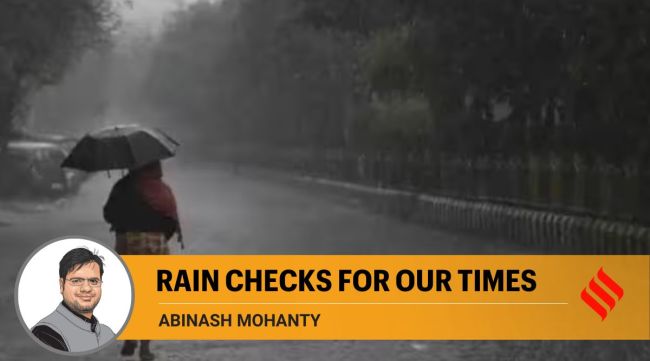Opinion When El Nino and the monsoon meet in India: Rain checks for our times
India needs to identify monsoon variability-related impacts, map associated hazards
 Instead of using alarmist language about climate change, it might be beneficial to persuade all sections of society to accept the shared responsibility to address climate change and make India monsoon-variability ready.
Instead of using alarmist language about climate change, it might be beneficial to persuade all sections of society to accept the shared responsibility to address climate change and make India monsoon-variability ready. The monsoon this year indicates that the climate has changed. El Nino is gaining momentum and making its presence felt. El Nino is characterised by the warming of the ocean surface temperatures in the Central and Eastern Equatorial Pacific Ocean. This can significantly influence weather patterns and ocean conditions. A delayed and unpredictable monsoon impacts lives, livelihoods and infrastructure. The increasing unpredictability of the monsoon — including incessant and record-breaking rainy days — is a cause for concern.
The Indian monsoon is a complex phenomenon influenced by various internal and external factors. El Nino is an external driver that modulates the monsoon’s intensity and spatial distribution. However, it is important to note that El Nino alone cannot account for all monsoonal variations. Other regional phenomena, such as the Indian Ocean Dipole and the Madden-Julian Oscillation, also significantly shape monsoon dynamics. El Nino is associated with weak monsoons and lower-than-average rainfall in India. Rainfall trends in India over 132 years suggest that severe drought and drought-like conditions have always occurred in El Nino years. The location of the El Nino event also influences its effects on the Indian monsoon — warming in the Central Pacific Ocean affects it more than the warming in the Eastern Pacific Ocean.
In June, the western coast of the country witnessed the high-intensity cyclone Biparjoy. The Central, Eastern and Northern parts experienced heat stress. Parts of the country saw delayed and erratic onset of the monsoon. This unpredictability will hurt the agriculture sector. More than three-quarters of India’s farmlands are rain-fed. Weak, erratic, or incessant rainfall will hurt lives and livelihoods. How can India tackle this challenge?
First, the country needs to identify the monsoon variability-related impacts and more importantly, map its associated hazards (landslides, flash floods, etc) risks, and vulnerability at the hyper-granular level. The mapping should include hard losses (infrastructure and finances) and soft losses (livelihoods, migration). India needs a high-resolution monsoon variability index to track critical vulnerabilities at the block and city level and simultaneously enhance early warning systems and forecasting.
Second, in order to address the socioeconomic risks posed by monsoon variability, India must embrace a proactive approach that integrates blended finance strategies. India’s central bank is closely monitoring El Nino and the monsoon’s patterns. By blending public and private capital, India can come to terms with the financial risks associated with the variability of monsoons. Mandatory reporting by the Task Force on Climate-related Financial Disclosures (TCFD) will enable lenders, insurers, and regulatory authorities to make risk-informed business decisions, foster resilient value chains, and minimise loss and damage. Embracing blended finance mechanisms enhances sectoral resilience and facilitates the adoption of effective risk-transfer mechanisms, providing the much-needed financial mechanisms for absorbing shocks from climatological disruptions like monsoonal variability.
Third, India must prioritise the restoration, revival, and rehabilitation of natural ecosystems like mangroves, wetlands, and forests. This should become a policy imperative. Restoration of degraded land in a sustainable manner can halt biodiversity loss and reinstate ecosystem services. Nature-based approaches offer holistic solutions to climate challenges and can help reduce flood and drought risk, improve water quality and protect coastal property. Investing in nature-based systems provides a cost-effective option to address climate change and other sustainable development goals while generating economic opportunities.
Instead of using alarmist language about climate change, it might be beneficial to persuade all sections of society to accept the shared responsibility to address climate change and make India monsoon-variability ready. The world has deferred climate action for too long. Any further delay will not only make things difficult for the current generation but also hurt the prospects of future generations.
The writer is sector head, Climate Change and Sustainability, IPE Global.
Views are personal






